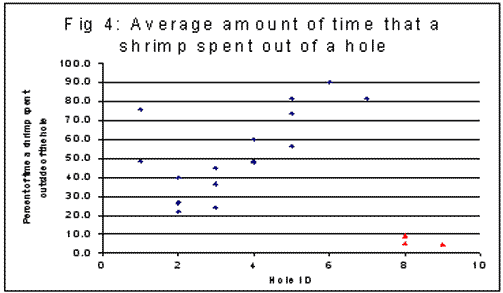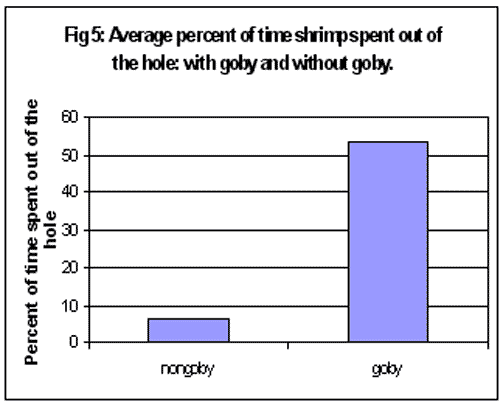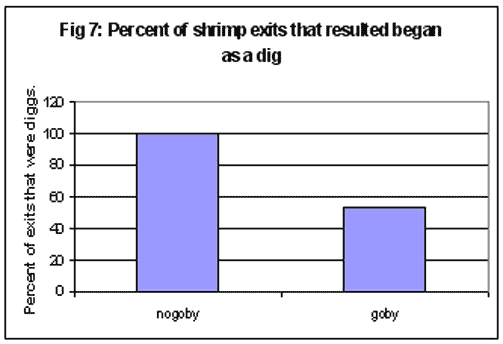Behavioral Study: Results
During the course of the study, several outstanding results came about. There was in fact a distinct change in the behavior of the shrimp as gobies were removed. 9 goby holes were measured – seven with gobies and nine without gobies, resulting in nineteen 1,000 second intervals. Many variables were measured for each hole that were later summed into three related measurements: Total amount of time a shrimp spent out of the hole, percent of times that a shrimp exit resulted in a dig, and the average amount of time that a shrimp bout lasted (Table 1).
Total amount of time a shrimp spent out of the hole:
One of the key indicators that the shrimp are affected was looking at the amount of time that the shrimp spent out of the hole. Since shrimp spend lots of time out of the hole normally manipulating particles and presumably gathering food, it is very striking that the shrimp decreased this activity dramatically when gobies were removed. In fact, they spent an average of 53.6 +/- 21.8 percent of their time outside of the hole when gobies were present but only 6.5 +/- 2.5 percent of their time outside of the hole when the gobies were removed (Table 2; Fig 4, 5).
Percent of times that a shrimp exit resulted in a dig:
Digging is used by shrimp to excavate their holes. At times the shrimp come out of the hole, not digging. Instead, they come out and move around the hole sometimes picking up pieces of detritus or algae and pull them back into the hole. Other times they come out without digging and after spending some time outside of the hole retreat back in without anything. They can not be coming out of the hole for hole maintenance but instead for another purpose. Thus, as each shrimp came out of the hole it was recorded whether or not it was digging. Shrimp that had a goby at the entrance dug on average 52.7 +/- 25.1 percent of the time while shrimp that had no goby dug 100 +/- 0.0 percent of the time (Table 2; Fig 6, 7). In other words, shrimp without a goby were never observed coming out of the hole except when they were digging.
Average amount of time that a shrimp ‘bout’ lasted:
While the percentage of times that a shrimp exited digging is a good way to determine the relative time spent outside of the hole not performing a hole maintenance task, it does nothing to give insight into the actual length of time a shrimp averages out of the hole each time it exits. Sometimes the shrimps dart in and out very quickly, just to dump a load of dirt. Sometimes they come out of the hole and spend a long time out of the hole. Presumably the length of a ‘bout’ (defined as time beginning from when a shrimp comes out of the hole to when it reenters the hole) is a good indication of the ‘skittishness’ of the shrimp. The average ‘bout’ time of a shrimp was significantly longer when there was a goby (14.0 +/- 6.4) as compared to when the goby was not present (2.9 +/- 0.25 ) (Table 2; Fig 8)
Table 2: Summed averages from the 9 shrimp holes of the average ‘bout’ time, Percent of time that shrimp were out of the hole, and % of shrimp exits that were digs.

Status of the shrimp-hole Average ‘Bout’ Time (Time a shrimp spent out of the hole) Percent of time shrimp were out of the hole Percent of Shrimp exits that were digs.




